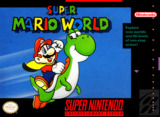Like the GBA remake of SMB3, the GBA version of SMW delivers like few other platformers can.
First off, the design for the game is a little bit different to the "typical" Mario game. It sort of fuses design from the illegitimate 2nd entry (by that I mean the US version) and the 3rd entry to create a colorful, vivid, and creative world unlike anything you've seen from a platformer. The levels are absolute eye candy on a number of occassions, and the animations that make up all the enemies and backgrounds of the game bring the game to life.
The sound is something you'll probably recognize, but it won't be the most recognizeable, admittedly. It's a soundtrack unlike that of the previous games, and it manages to enhance the feel of the game overall in ways few game soundtracks can. Little sound effects like Mario's spinning jump, Bullet Bills firing across the screen, etc, help establish a liveliness in this game I don't think many platformers manage to do.
The actual gameplay is the same as ever: you go from the left of the screen to the right, while dodging numerous obstacles, defeating enemies, and gathering coins along the way. In this game there are three power-ups: the Fire Flower, Starman, and Feather Cape, alongside the ever important Super Mushroom. This is the only downside of the game, is the shallow amount of power-ups. However, the two main power-ups, the Fire Flower and Feather Cape, are quite useful and you'll understand why other power-ups just aren't in the game. One thing in particular is the flight ability of the Feather Cape: get yourself running and you can actually FLY if you can keep a good control over Mario.
A new feature which I mentioned earlier is the spin jump. Where it doesn't launch you as high as the normal jump, you'll be able to defeat enemies which normally take 2 hits to defeat in just one, and you'll be able to shatter blocks below you if you land on them, opening up other paths. This jump ability is something they really ought to make useable in future Mario games: it's just plain satisfying not having to rely on a power-up every time you want to open up a secondary path.
The bosses are unique in this game, and their battlefields set the stage for future Mario games. Unlike Super Mario Bros. 3, boss stages are castles as opposed to airships, and rather than jump on the foe 3 times to defeat it, you have to jump on it pushing it back so it falls into a pit of lava. This can make bosses either more tricky yet more fun or more frustrating, but in most cases it doesn't bring down the overall experience of the game.
All in all, the GBA version features little in the way of upgrades. While it does feature some sound effects like some signature phrases by Mario, because the GBA and the SNES have similar graphic and sound capabilities, SMW doesn't feel like a "whole new experience" and the upgrades to it are slim. If you played Super Mario Bros. 3's GBA version, you saw how upgraded the graphics were without feeling like they overhauled the graphics: it looked like you thought you remembered it. As for Super Mario World, though, it looks and plays almost exactly like it did on the SNES. In fact, I wouldn't advise getting this game for GBA if you have it on SNES, but chances are you don't even have an SNES anymore.
But in the end, Super Mario World is just an awesome game, with a decent difficulty climb, plenty of secrets to find, eye-catching environments to dash through, and bosses to push into pits of lava. The GBA version doesn't feature much more than it's grand SNES version did aside from the addition of the original Mario Bros. released in 1983, but the GBA version cements SMW's place as one of the best 2D platformers you'll ever play. In ever right, it is as memorable and iconic as the original trilogy on the NES, and only shows why Super Mario is so trustworthy as a platforming series of the highest quality.
Final Score: 9.25

